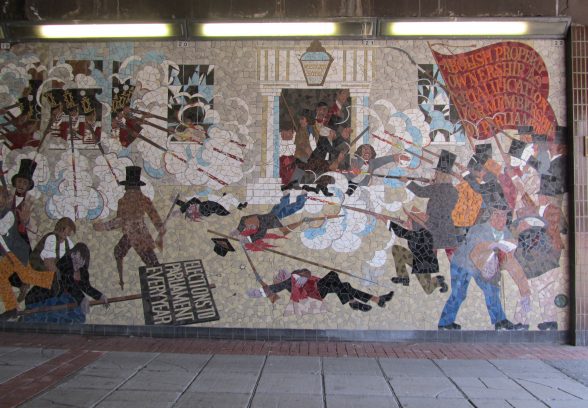This website uses cookies
This website uses cookies to enable it to function properly and to analyse how the website is used. Please click 'Close' to accept and continue using the website.



The Twentieth Century Society has just submitted one of Wales’ finest examples of post war public art to Cadw, the country’s heritage body, for listing. The beautifully executed and extraordinarily detailed mosaic in Newport city centre is threatened by re-development plans and new shopping centre proposals.
The 35m mural depicts the famous 1839 Chartist uprising in the city and is made from 200,000 pieces of ceramic tile and Venetian glass mosaic. The mosaic is so intricately designed that you can see subtle variations in colour, even different skin tones and expressions in the faces of the protesters in the mural. The surface of the mural is not flat – projecting elements like the spears and guns provide an added layer of detail that gives the mural 3-D qualities.
“It is an outstanding example of post war public art. The quality of design and execution are some of the best we have seen. In our view the mural should be listed for its historical associations with Newport, and its superb craftsmanship,” said Henrietta Billings, Senior Conservation Adviser, Twentieth Century Society.
“Listing the mural would help save it from demolition, and if necessary ensure its safe removal to a new location in the city,” she added.
More than 2000 people have signed an online petition (change.org) to save the mural which lines a covered walkway off John Frost Square.
The mural was constructed in 1979 by Kenneth Budd, a renowned figure in post war mosaics who produced a wide number of important public art commissions across Wales and the West Midlands. Budd started his career with William Mitchell, one of the best known English post war public artist – several of Mitchell’s works from the 1960s have been listed at our instigation.
The location of the Chartist Mural was deliberately chosen to be placed adjacent to John Frost Square to commemorate the events of 4 November 1839 and to act as a memorial to the 20 Chartists who were killed by soldiers outside the nearby Westgate Hotel.
John Frost, later Mayor of Newport, was one of the Chartists who had marched that day from the Monmouthshire valleys in support of their demands for reform of the parliamentary system then in operation. The six demands of the Great Charter were for voting by secret ballot, a vote for everyone aged over 21, annual elections to Parliament, all constituencies to have an equal numbers of voters, abolition of the property qualification for MPs and payment of MPs
The Society is currently running a campaign to raise public awareness of the importance of murals which form an essential part of the heritage of the United Kingdom. The threat to the Chartist Mural was highlighted in a well-publicised national conference on “Murals in Britain 1910-1970”, held in London in March 2013.
For further information, please contact Henrietta Billings at henrietta@c20society.org.uk or 0207 250 3857. Visit our Murals Campaign to see other notable C20 murals.

Become a C20 member today and help save our modern design heritage.